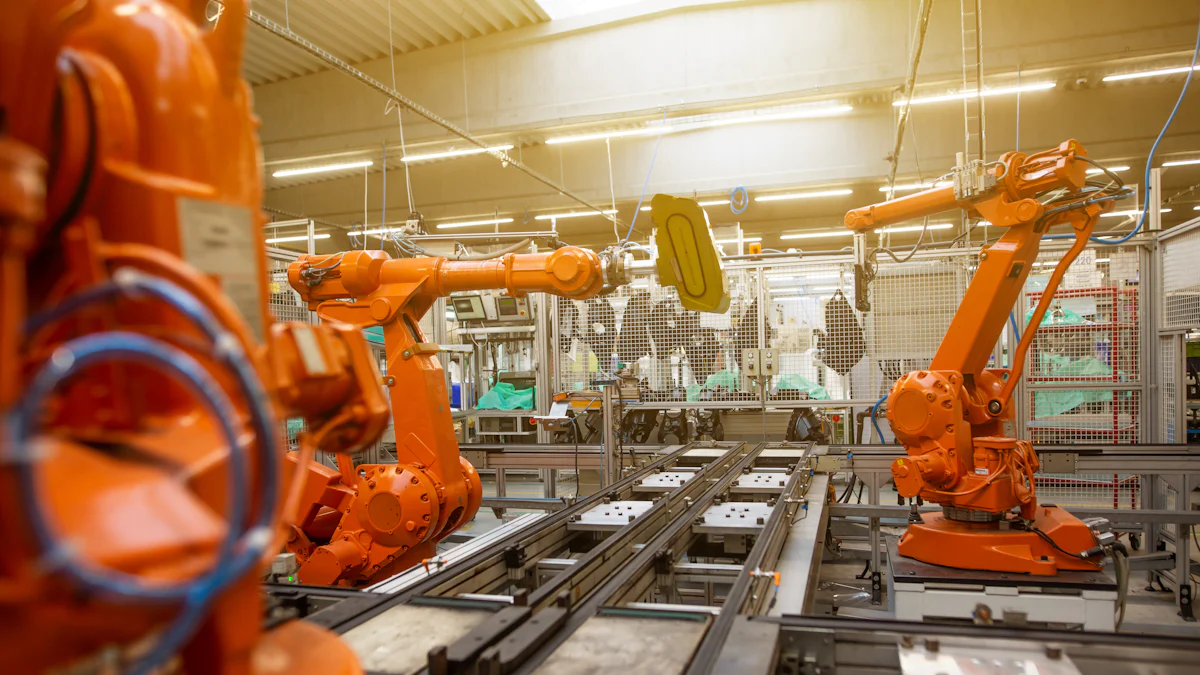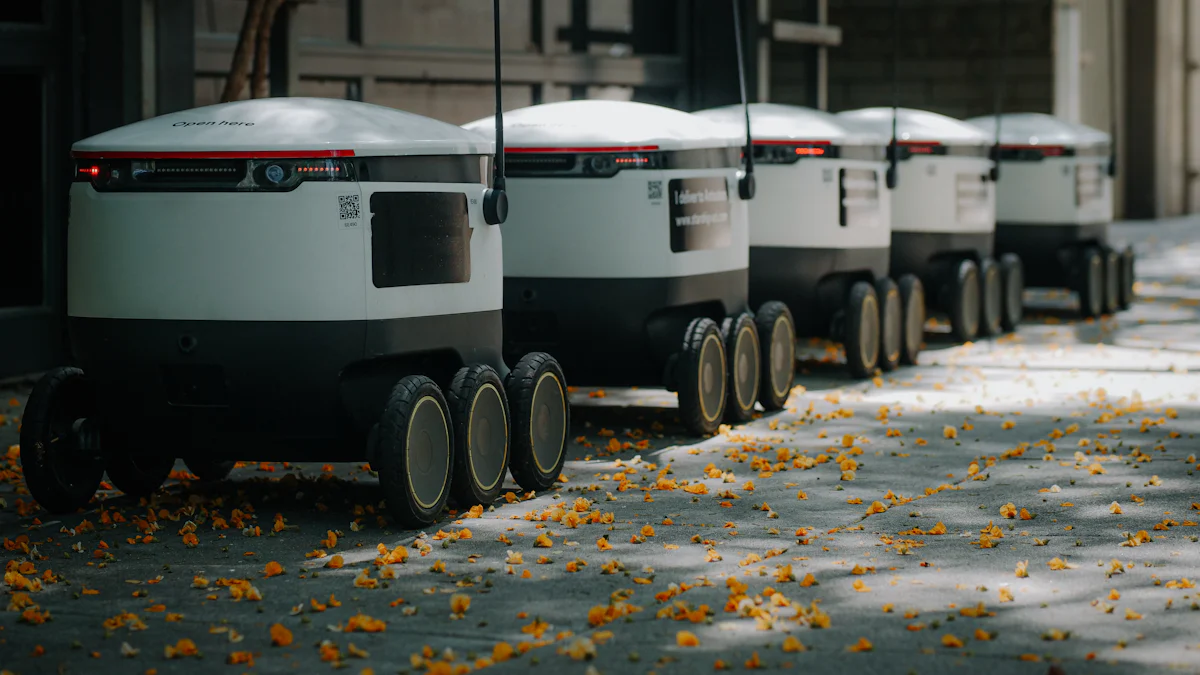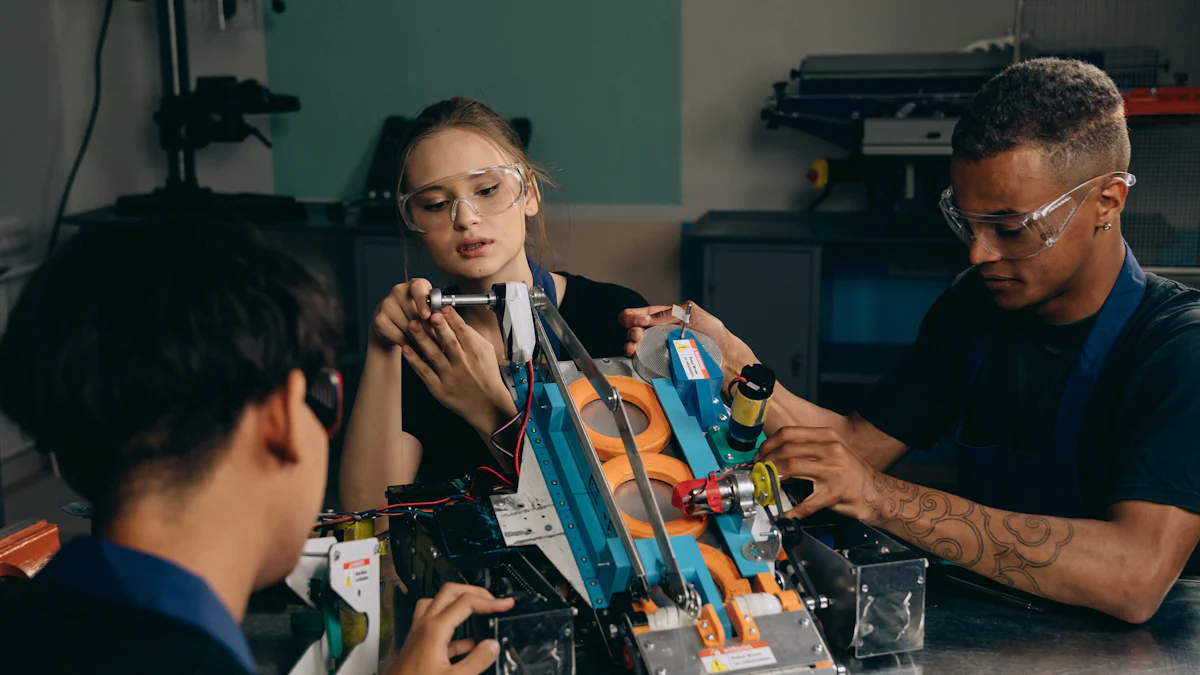Emerging Trends in Logistics Robotics: Market Dynamics to 2030

Logistics robotics represents a transformative force in the supply chain industry. Understanding market dynamics becomes crucial as businesses strive to stay competitive. The logistics robotics market is projected to reach USD 59.2 billion by 2030, growing at a CAGR of 16.8% from 2023 to 2030. This period will witness significant advancements and shifts, shaping the future landscape of logistics. Emerging trends will drive innovation and efficiency, making it essential for stakeholders to stay informed.
Current Market Overview
Market Size
Global Market Projections
The global logistics robotics market is set to experience substantial growth. Projections indicate the market will reach USD 59.2 billion by 2030. This growth reflects a compound annual growth rate (CAGR) of 16.8% from 2023 to 2030. Factors driving this expansion include technological advancements, increased investments in warehouse automation, and the adoption of Robotics-as-a-Service (RaaS) models.
Key Regional Markets
Key regional markets such as China and Southeast Asia are expected to play significant roles in this growth. China, with its rapid industrialization and technological advancements, leads in the adoption of logistics robots. Southeast Asia also shows strong growth momentum due to expanding logistical infrastructure and increasing trade activities. Emerging markets like India are anticipated to follow suit, driven by similar factors.
Key Technologies
Automated Navigation
Automated navigation stands as a cornerstone technology in logistics robotics. This technology enables robots to move efficiently within warehouses and distribution centers. Advanced algorithms and sensors guide these robots, ensuring precise and safe navigation. Companies invest heavily in improving automated navigation to enhance operational efficiency.
Sensor Technology
Sensor technology plays a crucial role in the functionality of logistics robots. Sensors provide real-time data about the robot's environment, enabling it to make informed decisions. These sensors include LiDAR, cameras, and ultrasonic sensors. The integration of advanced sensor technology enhances the robot's ability to perform complex tasks with high accuracy.
Artificial Intelligence
Artificial intelligence (AI) drives innovation in logistics robotics. AI algorithms enable robots to learn from their environment and improve performance over time. Machine learning and deep learning techniques allow robots to handle more complex tasks autonomously. AI integration also facilitates better decision-making and predictive maintenance.
Application Scenarios
Warehousing
Logistics robots find extensive applications in warehousing. Robots assist in tasks such as picking, packing, and inventory management. Automated guided vehicles (AGVs) and autonomous mobile robots (AMRs) streamline warehouse operations, reducing human intervention and increasing efficiency. The adoption of robotics in warehousing continues to grow as companies seek to optimize their supply chain processes.
JUSDA offers a comprehensive range of warehousing services through its cloud warehouse and integrated logistics solutions. The cloud warehouse service provides integrated support for multi-channel sales, achieving automated warehousing and intelligent transfer through a big data platform. It offers unified management of Vendor Managed Inventory (VMI) and Customer Managed Inventory (CMI), personalized VMI edge-of-production-line services, and seamless integration with clients' systems. The cloud warehouse is equipped with advanced warehouse planning and process design capabilities and holds certifications such as TAPA, C-TPAT, and ISO9001, ensuring efficient and secure logistics management.
JUSDA's warehousing services include various types of specialized storage, such as temperature-controlled warehouses, high-value goods warehouses, hazardous chemical warehouses, cold storage, bonded and non-bonded warehouses, and warehouses for electronic components, household appliances, daily necessities, cosmetics, food, and packaging materials. The company also excels in managing large-scale warehousing operations, handling over 340,000 SKUs and processing between 150,000 to 300,000 orders per day.
Additionally, JUSDA has established a global network of warehouses, including key locations in the US such as the Bohemia warehouse on the East Coast, the Rancho Cucamonga warehouse on the West Coast, and the Houston warehouse covering the Central and Southern US. These warehouses are strategically located near major airports and ports to ensure efficient inbound and outbound operations.
Overall, JUSDA's warehousing services are designed to support a wide range of industries and products, providing tailored solutions to meet the specific needs of their clients.
JUSDA
More than your expectation
Sorting
Sorting represents another critical application scenario for logistics robots. Robots equipped with advanced vision systems and AI algorithms sort packages based on size, weight, and destination. This automation speeds up the sorting process, reduces errors, and enhances overall productivity. Companies implement robotic sorting solutions to handle the increasing volume of parcels in e-commerce and logistics industries.
Distribution
In distribution centers, logistics robots play a vital role in streamlining operations. Robots assist in loading and unloading goods, transporting items within the facility, and managing inventory. The integration of robotics in distribution centers improves accuracy, reduces labor costs, and ensures timely delivery of goods. As demand for faster and more efficient distribution grows, the adoption of logistics robots in this sector is expected to rise.
The logistics robotics market exhibits robust growth prospects, driven by factors such as technological innovation, market demand, and regulatory imperatives. Market research reports indicate significant expansion in the coming years, with a compound annual growth rate (CAGR) exceeding expectations. Factors such as increasing investments in warehouse automation, robotics-as-a-service (RaaS) models, and Industry 4.0 initiatives contribute to market growth across regions.
Emerging Trends in Logistics Robotics

Technological Advancements
Advanced Autonomy
Advanced autonomy represents a significant leap in logistics robotics. Robots now possess higher autonomous decision-making capabilities. Enhanced sensors, artificial intelligence (AI), and machine learning empower these robots. These technologies enable robots to handle more complex tasks with precision and efficiency. Autonomous mobile robots (AMRs) can navigate intricate environments and plan optimal routes. This advancement reduces human intervention and increases operational efficiency.
Collaborative Robots
Collaborative robots, or cobots, are transforming logistics operations. These robots work alongside human workers, enhancing productivity while ensuring safety. Cobots perform repetitive and physically demanding tasks, reducing the risk of workplace injuries. The integration of cobots into logistics processes streamlines operations and improves throughput. Companies invest in collaborative robots to optimize their supply chain management.
Software Integration
Software integration plays a crucial role in the evolution of logistics robotics. Logistics robotic systems now integrate seamlessly with enterprise resource planning (ERP) and other IT systems. This integration facilitates real-time data exchange and enhances decision-making processes. Companies leverage software integration to achieve better coordination and efficiency in their logistics operations. The combination of robotics and software solutions drives innovation in the industry.
5G and the Internet of Things
The advent of 5G technology and the Internet of Things (IoT) revolutionizes logistics robotics. 5G communication technology enhances the real-time communication capabilities of robots. IoT enables remote monitoring and control of logistics robots, improving their performance. The synergy between 5G and IoT results in faster data transmission and reduced latency. This combination ensures that logistics robots operate efficiently and respond promptly to dynamic conditions.
Marketplace Expansion
Emerging Market Growth
Emerging markets exhibit strong growth potential in logistics robotics. Regions such as Southeast Asia and India experience rapid industrialization and infrastructure development. These factors drive the adoption of logistics robots in these markets. Companies recognize the opportunities presented by emerging markets and invest in expanding their presence. The growth of logistics robotics in these regions contributes significantly to the global market dynamics.
Segment Development
Segment development in logistics robotics focuses on customized solutions for specific industries. Industries such as cold chain logistics and pharmaceutical logistics demand specialized robotic solutions. These segments require precise temperature control and handling capabilities. Robotics manufacturers develop tailored solutions to meet the unique needs of these industries. The demand for segment-specific logistics robots continues to rise, driving innovation and market expansion.
Service-Based Business Models
Service-based business models are gaining traction in the logistics robotics industry. Robotics-as-a-Service (RaaS) offers flexible and scalable solutions for businesses. Companies can access advanced robotics technology without significant upfront investments. RaaS models provide maintenance, support, and upgrades, ensuring optimal performance. This approach allows businesses to adapt to changing demands and stay competitive in the market.
The logistics robotics industry is witnessing rapid advancements and marketplace expansion. Technological innovations such as advanced autonomy, collaborative robots, software integration, and 5G and IoT are driving this transformation. Emerging markets, segment development, and service-based business models further contribute to the industry's growth. Staying informed about these emerging trends is crucial for stakeholders aiming to leverage the full potential of logistics robotics.
Policies & Standards
Policy Support
Government Policies
Government policies play a crucial role in the development of logistics robotics. Policymakers implement regulations that encourage the adoption of advanced technologies. These policies aim to enhance efficiency and competitiveness in the logistics sector. Governments worldwide recognize the potential of logistics robots to transform supply chain operations. As a result, many countries introduce supportive measures to foster innovation.
Subsidy Measures
Subsidy measures provide financial incentives for companies investing in logistics robotics. These subsidies reduce the initial costs associated with adopting new technologies. Governments offer grants, tax breaks, and low-interest loans to encourage businesses to integrate robotics into their operations. Such financial support accelerates the deployment of logistics robots, driving market growth and technological advancements.
Standardization
Security Standards
Security standards ensure the safe operation of logistics robots. These standards address cybersecurity concerns and protect against potential threats. Companies must comply with stringent security protocols to safeguard data and maintain operational integrity. Security standards also cover physical safety measures to prevent accidents and injuries. Adhering to these standards builds trust and confidence among stakeholders.
Interoperability Regulations
Interoperability regulations facilitate seamless integration of logistics robots with existing systems. These regulations ensure that robots from different manufacturers can work together efficiently. Interoperability enhances the flexibility and scalability of logistics operations. Companies benefit from improved coordination and reduced complexity in their supply chain processes. Compliance with interoperability regulations promotes innovation and market expansion.
The logistics robotics industry faces challenges related to integration and cybersecurity. However, government policies and subsidy measures provide significant support. Standardization efforts focus on security and interoperability, ensuring safe and efficient operations. Emerging trends in policy support and standardization will continue to shape the future of logistics robotics.
Challenges and Opportunities

Technical Challenges
Cost Control
Managing costs remains a significant challenge in logistics robotics. High initial investments deter many companies from adopting robotic solutions. The expense of purchasing, installing, and maintaining robots can be prohibitive. Companies must find ways to reduce these costs to make robotics more accessible. Economies of scale and technological advancements may help lower these expenses over time.
Technology Maturity
The maturity of technology presents another hurdle. Many logistics robots still face limitations in terms of reliability and performance. Some robots struggle with complex tasks or operate inefficiently in certain environments. Continuous research and development are essential to overcome these issues. Companies need to invest in improving the robustness and versatility of their robotic systems.
Security Concerns
Security concerns pose a critical challenge in the deployment of logistics robots. Cybersecurity threats can compromise the integrity of robotic systems. Unauthorized access to robots can lead to data breaches or operational disruptions. Ensuring robust security measures is vital to protect against these risks. Companies must implement stringent cybersecurity protocols to safeguard their robotic operations.
Market Opportunities
Emerging Markets
Emerging markets offer substantial opportunities for logistics robotics. Regions such as Southeast Asia and India are experiencing rapid industrialization. The expansion of logistical infrastructure in these areas drives the demand for robotics. Companies can capitalize on this growth by entering these markets early. Establishing a presence in emerging markets can yield significant returns.
Technological Advancements
Technological advancements create new opportunities in logistics robotics. Innovations in robotics hardware, sensors, and navigation systems enhance the capabilities of robots. The integration of cloud computing, edge computing, and IoT connectivity improves efficiency. Collaborative robotics solutions enable robots to work alongside humans safely. These advancements open up new possibilities for automation in logistics.
The logistics robotics industry faces several technical challenges, including cost control, technology maturity, and security concerns. However, market opportunities abound in emerging markets and through technological advancements. Companies that navigate these challenges and seize these opportunities will thrive in the evolving landscape of logistics robotics.
The logistics robotics market is poised for substantial growth, driven by technological advancements and market demand. Key technologies such as automated navigation, sensor technology, and AI are revolutionizing the industry. Emerging trends like advanced autonomy, collaborative robots, and 5G integration will shape future developments. Staying informed about these dynamics remains crucial for stakeholders. The future of logistics robotics promises enhanced efficiency, agility, and resilience in supply chain operations. Embracing these innovations will enable businesses to thrive in an increasingly competitive landscape.
See Also
Uncovering Eco-Friendly Robotics: Trends in Supply Chain Innovation
Maximizing Warehouse Efficiency with Logistics Robotics
Discovering Robotics: Revolutionizing Supply Chain Operations
